A homeless man sleeps beside a wall covered with movie posters in Los Angeles [photo: Frederic J. Brown]: image via AFP Photo Department @AFPphoto, 21 July 2015
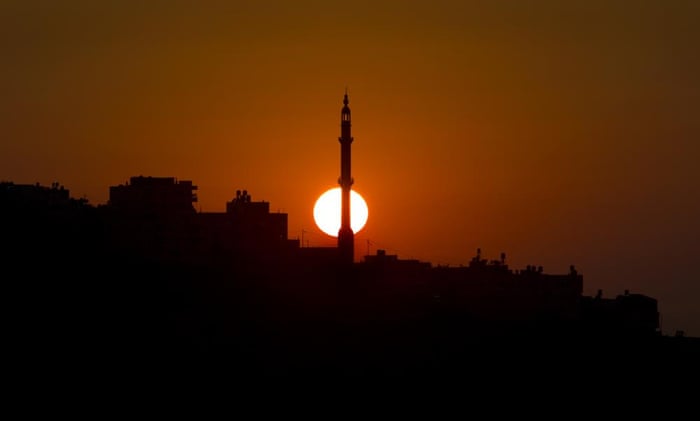
The sun sets behind the minaret of a mosque in Ramallah on 16 July, marking the end of the last fasting day of Ramadan: photo by Nasser Nasser/AP, 16 July 2015
Holiday on the West Bank: House Raid
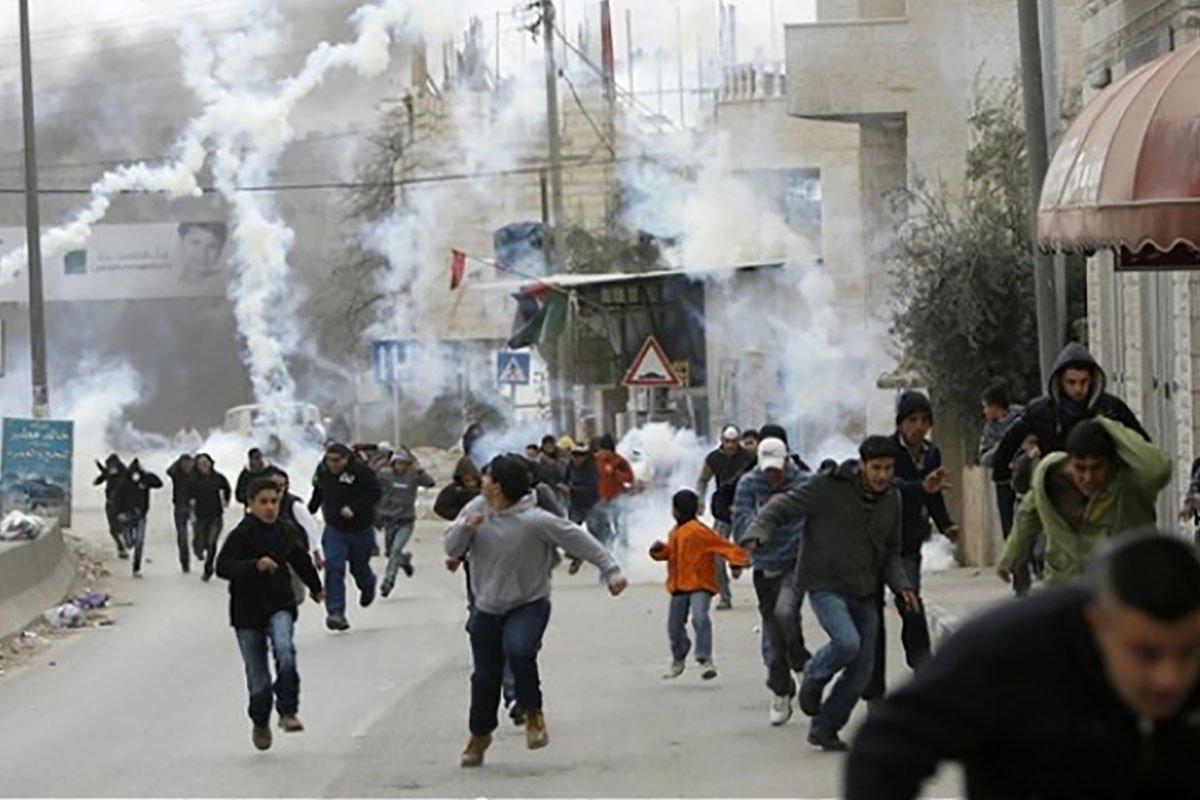
Israeli army kills Palestinian man while trying to arrest his son #West Bank: image via Middle East Monitor @MiddleEastMnt, 23 July 2015
Israeli soldiers kill Palestinian in West
Bank: Palestinian doctor in Hebron identifies man who died in house
raid, in which two others were injured, as Falah Abu Maria: Reuters in
Ramallah, Thursday 23 July 2015
Israeli soldiers have killed a Palestinian and wounded two others
during a raid on a house in the occupied West Bank, according to
Palestinian medical officials.
An Israeli military spokeswoman said soldiers were attacked while trying to arrest a suspect in the village of Beit Ummar and opened fire on the main attacker.
As the forces left the scene, the spokeswoman said, they were attacked once more, with rocks and bricks, and “responded to the assaults with fire towards the main instigator”.
A Palestinian doctor in a Hebron hospital said a 52-year-old man had been shot and killed and two of his sons were injured. The doctor identified the man as Falah Abu Maria.
Yusuf Abu Maria, an anti-Israeli settlement activist in the town, said there had not been any clashes and that the shooting had taken place inside a house.
On Wednesday, a Palestinian was killed in a separate arrest raid when clashes erupted with residents.
Israeli troops enter Palestinian-controlled territory frequently to detain people suspected of militant activity. Palestinians condemn this practice as an encroachment on the limited self-rule they hold in parts of the West Bank.

Israeli forces kill Palestinian Falah Hamdi Abu Maria in the town of Beit Ummar in the West Bank while trying to arrest his son: Middle East Monitor, 23 July 2015
The Israeli army on Thursday killed a Palestinian man in the West Bank while trying to arrest his son.
Witnesses told Anadolu Agency that Israeli forces killed Falah Hamdi Abu Maria in the town of Beit Ummar.
Medical reports said he was shot in the chest.
"Dozens of Palestinians have begun arriving at Abu Maria's house, amid anger in the town," witnesses added.
On Wednesday, Israeli military forces killed a young Palestinian man in the northern West Bank.
More than 20 Palestinians have been killed and another 2,156 have been detained by the Israeli military in 2015, the Palestine Liberation Organization (PLO) said in a report issued earlier this month.

23 July Dozens of Palestinians in the #WestBank city of al-#khalll participate in the funeral of martyr Falah Abu Maria, 52: image via Al Qassam Brigades @qassamsms, 23 July 2015

An Israeli military spokeswoman said soldiers were attacked while trying to arrest a suspect in the village of Beit Ummar and opened fire on the main attacker.
As the forces left the scene, the spokeswoman said, they were attacked once more, with rocks and bricks, and “responded to the assaults with fire towards the main instigator”.
A Palestinian doctor in a Hebron hospital said a 52-year-old man had been shot and killed and two of his sons were injured. The doctor identified the man as Falah Abu Maria.
Yusuf Abu Maria, an anti-Israeli settlement activist in the town, said there had not been any clashes and that the shooting had taken place inside a house.
On Wednesday, a Palestinian was killed in a separate arrest raid when clashes erupted with residents.
Israeli troops enter Palestinian-controlled territory frequently to detain people suspected of militant activity. Palestinians condemn this practice as an encroachment on the limited self-rule they hold in parts of the West Bank.

23 July Dozens of Palestinians in the #WestBank city of al-#khalll participate in the funeral of martyr Falah Abu Maria, 52: image via Al Qassam Brigades @qassamsms, 23 July 2015
Israeli forces kill Palestinian Falah Hamdi Abu Maria in the town of Beit Ummar in the West Bank while trying to arrest his son: Middle East Monitor, 23 July 2015
The Israeli army on Thursday killed a Palestinian man in the West Bank while trying to arrest his son.
Witnesses told Anadolu Agency that Israeli forces killed Falah Hamdi Abu Maria in the town of Beit Ummar.
Medical reports said he was shot in the chest.
"Dozens of Palestinians have begun arriving at Abu Maria's house, amid anger in the town," witnesses added.
On Wednesday, Israeli military forces killed a young Palestinian man in the northern West Bank.
More than 20 Palestinians have been killed and another 2,156 have been detained by the Israeli military in 2015, the Palestine Liberation Organization (PLO) said in a report issued earlier this month.

23 July Dozens of Palestinians in the #WestBank city of al-#khalll participate in the funeral of martyr Falah Abu Maria, 52: image via Al Qassam Brigades @qassamsms, 23 July 2015

23 July Dozens of Palestinians in the #WestBank city of al-#khalll participate in the funeral of martyr Falah Abu Maria, 52: image via Al Qassam Brigades @qassamsms, 23 July 2015
Holiday in Gaza
A Palestinian man takes a picture of his daughter at sunset at the sea port in Gaza City [photo: Mohamed Abed]: image via Agence France-Presse @AFP, 22 July 2015
A man hangs ears of corn out to dry before selling them on the beach in #Gaza. Photo by #MohammedAbed #AFPphoto: image via Catherine Weibel @Catherine Weibel, 18 May 2015
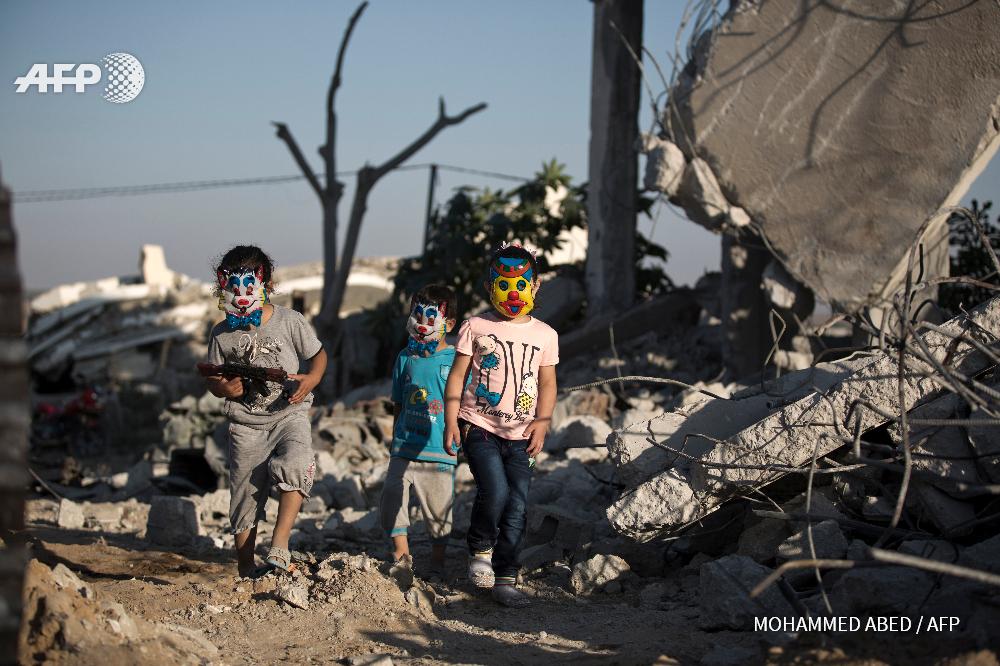
#Gaza City - Palestinians in rubble of buildings destroyed during the 50-day war. By Mohammed Abed #AFP: image by AFP Photo Department @AFPphoto, 22 July 2015
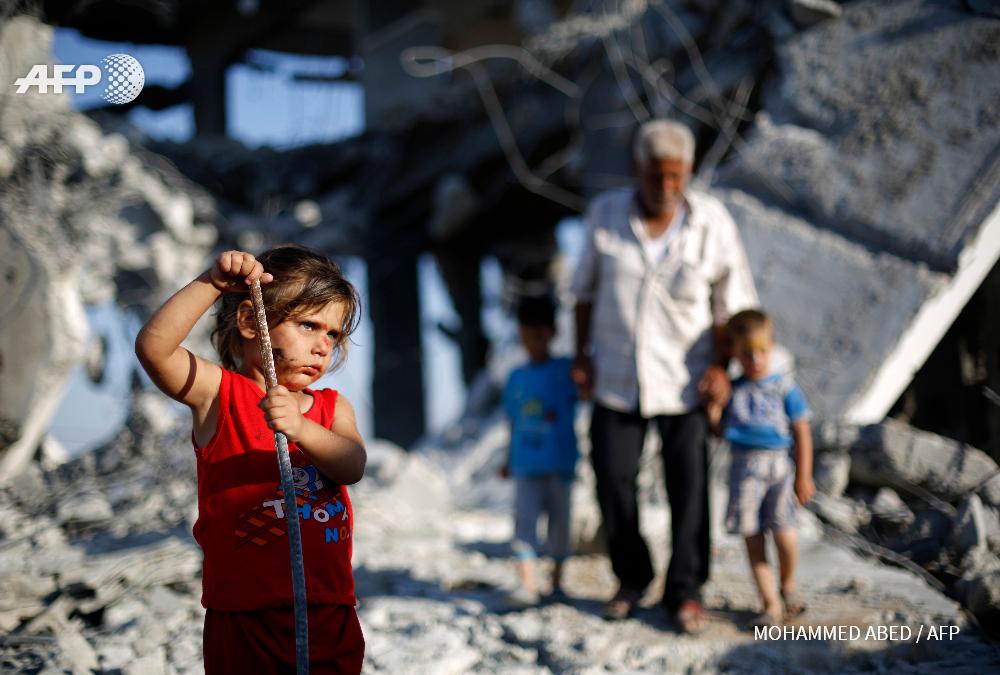
#Gaza City - Palestinians in rubble of buildings destroyed during the 50-day war. By Mohammed Abed #AFP: image by AFP Photo Department @AFPphoto, 22 July 2015
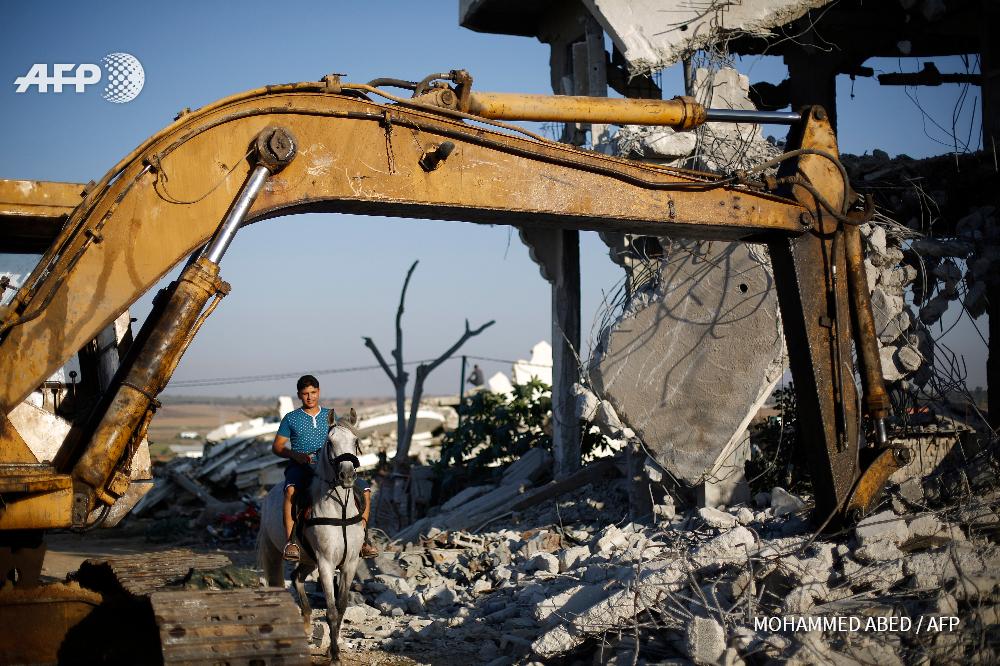
#Gaza City - Palestinians in rubble of buildings destroyed during the 50-day war. By Mohammed Abed #AFP: image by AFP Photo Department @AFPphoto, 22 July 2015
A Palestinian street vendor carries balloons on a street in #Gaza City. #MohammedAbed #AFPphoto: image via UNICEFpalestine @UNICEFpalestine, 18 May 2015
Palestinian children pose for picture on a makeshift boat at the port of #Gaza City. #MohammedAbed #AFPphoto: image via UNICEFpalestine @UNICEFpalestine, 20 May 2015
Un petit garçon regarde une lampe de #Ramadan sur un marché de #Gaza City. Photo by #MohammedAbed #AFPphoto RamadanKarim!: image via Catherine Weibel @Catherine Weibel, 18 June 2015
Holiday on the West Bank: Don't Level My Village
- We ain't going anywhere sweetie @YDan10 @purplhaze42 @canarymission @charlesfrith @umm_hashim @avibono: image via Shim Rational @shimrational, 30 May 2015
More than 900 Israeli settlement housing units approved #West Bank: image via Middle East Monitor @MiddleEastMnt, 23 July 2015
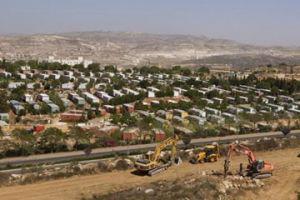
[Middle East Monitor:] 651k Israeli settlers live in 185 illegal settlements and 220 unauthorised locations in #WestBank and Jerusalem at the start of
2015: image via Palestine @ops_pal, 18 July 2015
US, EU take strong stand against Israeli demolition plan: Akiva Eldar, Al-Monitor Israel Pulse, 20 July 2015
The timing of the announcement by US State
Department spokesman John Kirby regarding the Barack
Obama administration’s position on the small Palestinian village of Susiya
was no less important than its content. Kirby made the statement July
16, as the administration was going out of its way to douse the flames
in US-Israeli relations following the signing of the nuclear agreement with Iran.
While
world opinion speculated about the effect of the
Iran agreement on US-Israeli relations, Kirby arrived for his briefing
armed with a stern declaration about the potentially far-reaching
implications of the planned demolitions in Susiya in the Judean
Mountains south of Hebron.
Kirby made clear that the consequences of Israel's harassment of
Susiya residents would extend beyond the demolitions’ impact on the
villagers and their families. He noted that the planned expulsions and
land appropriations in Susiya were particularly glaring given the
settlement activity in that same region. Several hours beforehand, Dorothy Shea, acting
US consul general in Jerusalem, had used similar language. She, too,
urged Israeli authorities to abstain from demolishing the homes in the
village. These sharp public pronouncements thus turned the Susiya affair
into the first test of Israeli foreign relations in the post-Iran
nuclear crisis era.
According to information acquired by human rights organizations in
Israel and the territories, the Israeli civil administration did not
wait until the end of the month of Ramadan to hand out demolition orders
for 37 structures. It intends to carry out the orders before Aug. 3,
the date set for the Supreme Court to hear an appeal submitted by the
Palestinians and these organizations.
European
capitals are also eyeing with concern the bulldozers parked
outside the tiny village, whose residents have the dubious distinction
of living in a region of the West Bank known as Area C. The Oslo Accord
divided the West Bank into three zones -- A, B and C -- with Area C
under complete Israeli control.

A Palestinian man, Jihad Nuwaja, stands next to a tent in Susiya village, south of the West Bank city of Hebron: photo by Mussa Qawasma/Reuters, 20 June 2015
On June 29, the European Union’s ambassador to Israel, Lars
Faaborg-Andersen, said the EU’s humanitarian affairs agency had reported
that every month, Israel destroys five to seven projects that the union
funds in Area C. “We’re talking about European taxpayer money,” the
envoy said at a conference on Susiya
held by the Van Leer Jerusalem Institute. The ambassador stressed that
European aid does not free Israel of its responsibility under
international humanitarian law to ensure a reasonable quality of life
for the Palestinian population under its control. He noted that Area C
constitutes some 60% of the West Bank and, therefore, is a key to the
establishment of a future Palestinian state.
According to EU data, said Faaborg-Andersen, recent years have
brought an increase in the number of demolitions in the region (in
addition to extensive demolitions in Bedouin villages
in Israel). He explained that this stems from the minute number of
building permits Israel grants the residents of Palestinian villages
throughout Area C.
“If people knew where they could build,” Faaborg-Andersen said, “it
would prevent construction without permits and demolition orders.” He
added that Yoav “Poli” Mordechai, coordin
“Unfortunately,” Faaborg-Andersen remarked, “the master plan process
has been taken hostage by other events that have been going on between
Israel and the Palestinians,” such as complaints against Israel lodged
by the Palestinian leadership with international organizations. Like the
American speakers, Faaborg-Andersen did not forget to mention that even
as Palestinian homes are being destroyed, the settlements are taking
over more and more land for construction and security needs.
One can assume that Prime Minister Benjamin Netanyahu is not keen to
see footage of bulldozers destroying the homes of indigent Palestinians
on television screens worldwide, bumping reports on the condition of
human rights in Iran. Even if the prime minister could be persuaded that
he should seek a way out of this affair, he could expect a fair number
of obstacles along the way.

A Palestinian woman holds a Palestinian flag in the West Bank village of Susiya: photo by Baz Ratner/Reuters, 24 June 2012
On
the one hand, the international community is pressing him to stop the
bulldozers. On the other, Netanyahu is being held hostage
by the settlers and their representatives in the leadership of the
Likud and HaBayit HaYehudi parties. They will not leave him alone until
he wipes out the village stuck in the craw of the settlers of the south
Hebron Hills. Yisrael Beitenu, the right-wing opposition party led by
former Foreign Minister Avigdor Liberman, would have a field day were
Netanyahu to surrender to the left.
This
equation is missing an important element -- the Israeli left-wing
opposition. The Zionist Camp has once again left the Meretz Party to
face the right alone. The silence of the main opposition party on the
Susiya affair can be added to the absence of its members from the vote
on force feeding hunger-striking Palestinian prisoners held on
security-related offenses, its vote in favor of the nationality bill
that tears apart Palestinian families, its support for thwarting peace
activists’ Marianne flotilla to Gaza and its competition with Netanyahu
to slam the Iran agreement.
This time as well, Meretz was the sole Zionist party to rush to the
defense of the downtrodden. This time, too, a handful of Israeli peace
activists -- led by members of the organizations Ta’ayush (Living
Together, in Arabic), B’Tselem and Rabbis for Human Rights -- are
standing by the weakest group among the occupied Palestinian
population. A chosen few among them, like professor David Shulman, serve
as voices delivering the shepherds’ and farmers’ messages to
air-conditioned administrative offices in Washington and at European
Union headquarters in Brussels.
In
his book Dark Hope: Journal of a Ta'ayush Activist, Shulman,
a member of the Israeli Academy of Sciences and recipient of the
prestigious Emet Prize, writes about how he and his friends collected
poison pellets that the settlers had scattered to kill the Palestinian
residents’ goats and sheep, planted olive trees to replace the ones
uprooted by settlers, helped a farmer cross the few yards to his
well and provided blankets for uprooted Palestinian cave dwellers.
“Two
relentless national movements are engaged in a conflict, street
to street, house to house,” Shulman wrote. “One side is infinitely
stronger than the other, but not more magnanimous. It abuses its power
over and over -- the tremendous machine of a state and army and
judiciary -- in order to disown, threaten, expropriate, control,
destroy.”
The well-oiled mechanism of the major powers proved in reaching an
agreement with Iran in Vienna on July 14 that it can use its power to
achieve compromise, to bridge, to rehabilitate and to build. Now this
mechanism is free to focus on dismantling the ticking time bomb on the
heights of the Hebron Hills.
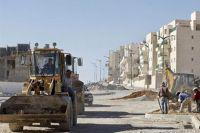
[Middle East Monitor:] 651k Israeli settlers live in 185 illegal settlements and 220 unauthorised locations in #WestBank and Jerusalem at the start of
2015: image via Palestine @ops_pal, 18 July 2015
West Bank villagers deliver final plea to save homes from destruction: Shlomi Eldar, Al-Monitor Israel Pulse, 20 July 2015
On
July 12, the residents of the Palestinian village of Khirbet Susiya,
located in the Mount Hebron area of the West Bank, had a meeting with Gen. Yoav (“Polly”) Mordechai, the commander of the Israeli military's Coordinator of Government Activities in the Territories unit. It
was only then that they discovered that at the beginning of August, the
Civil Administration, which administers civilian activity in the West
Bank on behalf of the Israeli government, plans to demolish half of the structures in the village.
If this happens, the curtain will fall on the legal battle
they have been waging against the state for more than 20 years, ever
since they were expelled from the caves where they had previously lived
and which were designated a national park. After their expulsion, they
set up several temporary structures on farmland they cultivated while
they were living in the caves. According to the state, these structures
are illegal. Israel plans to relocate the residents of Khirbet Susiya to
Area A in the environs of the village of Yatta. Khirbet Susiya
is located in Area C. Under the 1993 Oslo Accord, Area C is under full
Israeli control, while Area A is under full Palestinian civil and
security control.
Some
350 people currently live in Khirbet Susiya, half of whom are under 18.
Located nearby is the Jewish settlement of Susiya that was established
in 1983. Some of the residents of the
Palestinian village who used to live there had given up because of the
harsh conditions and unending legal battles. Instead, they moved to the
area controlled by the Palestinian Authority.
“One day, in 1986, we were notified that we had to leave
our village and go somewhere else. We were never given the opportunity
to protest and no alternative location was offered. I was a child back
then and I remember the trauma,” Salah Nawajeh, a resident of Khirbet
Susiya, told Al-Monitor. “We were given a couple of days. Then the
military showed up, put up fences and we were barred from going in. This
was our land, our life, our homes. We were told that that was an
archaeological site and that from that moment on it would be run by the
settlers. But we came [to the cave village] because we were banished
from our first natural territory.”
Salah’s father, Muhammad Nawajeh, told Al-Monitor, “We used
to live in the area of Tel Arad [in the eastern part of the Negev
Desert]. We had been there all our lives, since the times of the
Ottomans and the British. We stayed there even after [Israel’s 1948 War
of Independence]. In 1952 we were banished for the first time and then
we built our village in Susiya. We dug caves and water wells. In 1986 we
were expelled from there, too. Now we are being banished for the third
time. I’m already 70. I’m old and tired. I was born before Israel was
founded on this land, and this is where I want to die. All I can
remember from the Jews is banishments.”
The residents of Khirbet Susiya claim that for years their
requests for construction permits were denied. Two years ago, they
submitted to the Civil Administration a zoning blueprint they had
prepared with the hope that the living structures they had built would
be legalized. However, the Civil Administration rejected the plan,
arguing that it did not meet the basic standards of living. With the
help of the organization Rabbis for Human Rights, the residents filed an
appeal with the Supreme Court against the rejection of the blueprint.
Concurrently, they requested that the demolition orders be stayed
pending the court hearing. In May of this year, Justice Noam Solberg
turned down their petition. In the wake of the ruling, the residents
have been looking for a new avenue for their struggle: international
pressure.
In fact, already in 1986, in a bid to dissuade Israel from
uprooting them from their land, the residents of Khirbet Susiya turned
to the US ambassador to Israel, Thomas Pickering, asking that he
intervene on their behalf. Pickering, they say, pledged to assist them,
but two weeks later the area where they had been living was fenced off
with barbwire. Now they have approached the US Embassy
once again, asking that it pressure Israel not to demolish the village.
It appears that their efforts have not been unsuccessful.
“An assistant and an attache from the embassy came to see
us,” Salah said. “We explained to them about our legal battles against
the State of Israel for the past 20 years and how everything works here
in Susiya, with pressure brought to bear by the settlers. I told [the
Americans] that in 1986 the ambassador promised that we would not be
banished, but he didn’t keep his word. That’s why I asked that they not
let us down again. Our fate, our lives are in their hands. If the
Americans don’t exert pressure on the Israeli government, we, the
residents of the village who have been living here for centuries, will
be expelled again. This will be a blot on everyone’s reputation for
generations to come.”
Recently,
the Civil Administration has started promoting
the demolition of the structures, submitting to representatives of the
residents a list of the structures slated for demolition. As noted, the
residents of Khirbet Susiya claim that the Civil Administration is being
pressured by the settlers and that they heard things in this vein
during their meeting with the Coordinator of Government Activities in the Territories.
In response to this allegation, the Civil Administration says that
Mordechai, on his own initiative, invited representatives from the
village and their attorneys to find alternative solutions in keeping
with planning considerations.
Presently, the residents of Khirbet Susiya refuse to accept
the proposed solutions, claiming that the land has been theirs for
many generations.
“We turned to whoever we could,” Salah said. ‘We used the
Americans and the Europeans and even the Palestinian Authority. If the
houses are demolished, we will turn to the International Criminal Court
in The Hague. If Israel talks about coexistence and peace, it’s time to
show it and not act because of pressure from the settlers. They have
brought calamity on us ever since they arrived here and took over our
lands. It was only a week ago that they uprooted four old olive trees,
and they keep stopping us from working our land. That’s the reality of
things and this is what we’re fighting against.”
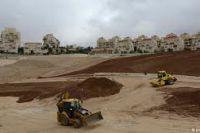
[Middle East Monitor:] 651k Israeli settlers live in 185 illegal settlements and 220 unauthorised locations in #WestBank and Jerusalem at the start of
2015: image via Palestine @ops_pal, 18 July 2015
Israel, Don't Level My Village; Nasser Nawaja in Susiya, West Bank for New York Times, 23 July 2015
In 1948, as Israeli forces closed in on his village of
Qaryatayn, my grandfather carried my father in his arms to Susiya, about
five miles north, in the South Hebron Hills area.
“We will go back home soon,” my grandfather told my father.
They did not. Qaryatayn was destroyed, along with about 40 other Palestinian
villages that were razed between 1948 and the mid-1950s. My family
rebuilt their lives in Susiya, across the 1949 armistice line in the West Bank.
In
1986, my family was expelled from our home once again -- not because of
war, but because the occupying Israeli authorities decided to create an
archaeological and tourist site around the remains of an ancient
synagogue in Susiya. (A structure next to the abandoned temple was used
as a mosque from about the 10th century.) This time, it was my father
who took me in his arms as the soldiers drew near.
“We will return soon,” he said.
We did not. Without compensation, we were forced to rebuild Susiya nearby on what was left of our agricultural lands.

A Palestinian child runs in the village of Susiya on the West Bank: photo by Rina Castelnuovo for The New York Times 23 July 2015
If, in the coming weeks, the Israeli government carries out demolition orders served on some 340 residents
of Susiya, I will be forced to take my children in my arms as our home
is destroyed and the village razed once again. I do not know if I will
have the heart to tell them that we will soon go home; history has
taught me that it may be a very long time until we are able to return.
In 2012, the Civil Administration branch of Israel's Defense Ministry issued
demolition orders against more than 50 structures in Susiya, including
living quarters, a clinic, shop and solar panels. The reason given in
these orders was that our village was built without permits from the
Israeli military authorities.
The
new Susiya was built on Palestinian villagers’ private agricultural
land, but that is no safeguard. In practice, it is virtually impossible
for a Palestinian living in what is known as Area C -- the 60 percent of
the West Bank under both civil and security control of the Israeli
military -- to receive a building permit. According to Bimkom,
an Israeli nonprofit focused on planning rights, more than 98 percent
of Palestinian requests for building permits in Area C from 2010 to 2014
were rejected.
The
threat has now become immediate. Following the initial distribution of
demolition orders, there was a political and legal campaign spearheaded
by the residents of Susiya that had support from Palestinian, Israeli
and international activists and rights groups. The village was not
demolished, our case returned to the courts and the pressure let up.
But
this past May, a few months after the re-election of Prime Minister
Benjamin Netanyahu, the Israeli Supreme Court justice Noam Sohlberg, who
himself lives in an Israeli settlement that is considered illegal
under international law, caved in to pressure from right-wing and
settler organizations and ruled in the High Court that the Israeli
military could go ahead with demolitions in the village -- despite the
fact that the higher-ranking Supreme Court had scheduled a hearing for our case on Aug. 3.
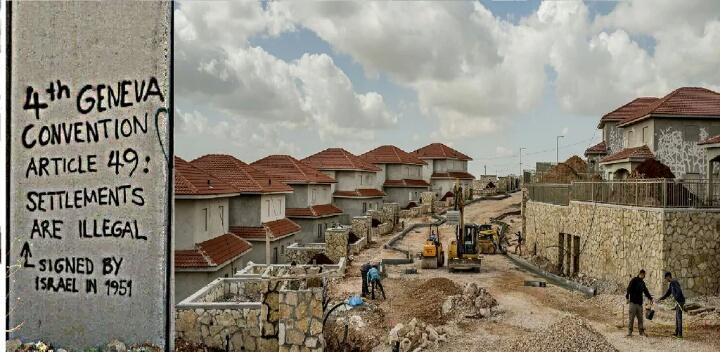
[Middle East Monitor:] 651k Israeli settlers live in 185 illegal settlements and 220 unauthorised locations in #WestBank and Jerusalem at the start of
2015: image via Palestine @ops_pal, 18 July 2015
Earlier
this month, I learned from lawyers working against the demolition of
Susiya that representatives of the Israeli military had stated their
intent to demolish parts of our village before the Aug. 3 hearing. Since
the May ruling, we in Susiya have been grateful for an outpouring of
support and solidarity. Last week, the State Department’s spokesman,
John Kirby, made a strong statement on the issue.
“We’re
closely following developments in the village of Susiya, in the West
Bank,” he said, “and we strongly urge the Israeli authorities to refrain
from carrying out any demolitions in the village. Demolition of this
Palestinian village or parts of it, and evictions of Palestinians from
their homes, would be harmful and provocative.”
That
was a step in the right direction, but we need more than mere
declarations now. If the Israeli government demolishes all or part of
Susiya once again, it will be for no other reason than that we are
Palestinians who refused to leave, despite immense pressure and great
hardships of daily life under occupation.
The
situation in Susiya is only one of many such situations in Area C of
the West Bank. Several villages near ours have pending demolition orders
as well. If Susiya is destroyed and its residents expelled, it will
serve as a precedent for further demolitions and expulsions through the
South Hebron Hills and Area C of the West Bank. This must not be allowed
to happen.
This
story is not a story of Jews against Muslims, or even a story of
Israelis against Palestinians. We’re grateful for the many messages of
support our village has received from Jewish communities around the
world, and the groups and activists working by our side include many
Israelis. This is simply a story of justice and equality against
dispossession and oppression.
Nasser Nawaja is a community organizer and a field researcher for the Israeli human rights organization B’Tselem.
At any moment, Israeli occupation forces may demolish Palestinian village of Susiya near Hebron: image via Ben White @benabyad, 1 June 2015
-
At any moment, Israel’s Civil Administration (CA) might demolish all homes and structures in Khirbet Susiya, a small Palestinian village in the South Hebron Hills, the West Bank. On 4 May 2015, Israel’s High Court of Justice (HCJ) denied a request for an interim injunction that would prevent the CA from implementing the demolition orders it had issued. The request was made during a hearing of a petition filed by the villagers, the latest measure in their battle against efforts by Israeli authorities to forcibly transfer them from their homes in Area C to Area B or A, as part of a policy to annex the area de-facto to Israel. Demolition would effectively mean banishing the residents from their land and their village. The residents of Khirbet Susiya were expelled from the original site of their village in the 1980s, after the CA declared it a “national park”. They then took up residence on their farmland but the Israeli authorities tried to expel them from there, too. After a protracted legal battle, the villagers remained on the farmland, but the CA issued demolition orders for all their homes and refused to authorize the master plan they drew up for the new village. In response, the residents petitioned the HCJ with the help of Israeli NGO Rabbis for Human Rights. They argued that the CA had rejected their master plan on discriminatory grounds and requested that the court issue an interim injunction to stay the demolition until the petition is heard. Justice Noam Solhberg denied the request. Without homes to live in, the residents will remain without shelter in harsh desert conditions. Demolishing all structures in the village would be both cruel and illegal. International occupation law prohibits both the demolition of homes in such circumstances and the forcible transfer of an occupied population. Based on past experience, if the residents are forced to leave their land, settlers will take it over with the support of the state -- as they have already done with 300 hectares of village land. We can help the villagers fight for their land. They want to stay in their homes and need our help making their story public knowledge. At present it is virtually unknown to the world. -- via btselem. org, 1 June 2015
-

- Village of Khirbet Susiya, faced with demolition: photo via btselem. org, 1 June 2015
-

- Residents of village og Khirbet Susiya, threatened with Israeli demolition: photo via btselem. org, 1 June 2015
- I want this to be a picture of dignity: a true canvas of the suffering of humanity. #MohammedAbed #Gaza: image via Jean Stürgoen @asicjk, 18 November 2013
-
A Palestinian girl plays outside a tent in the southern West Bank village of Susya on Wednesday. Israel’s High Court ruled in May that Susya’s 340 residents could be relocated and its structures demolished: photo by Hazem Bader/AFP, 22 July 2015
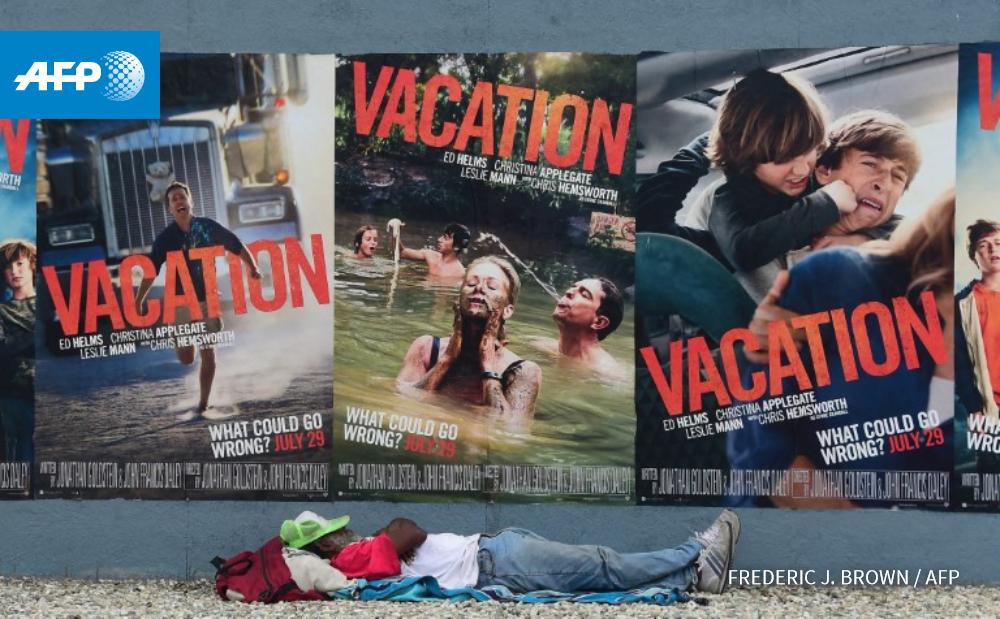


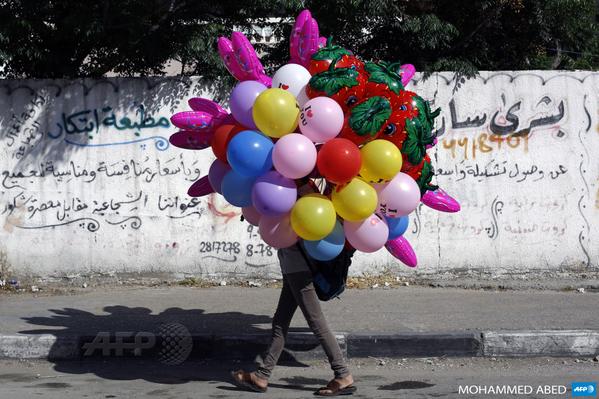



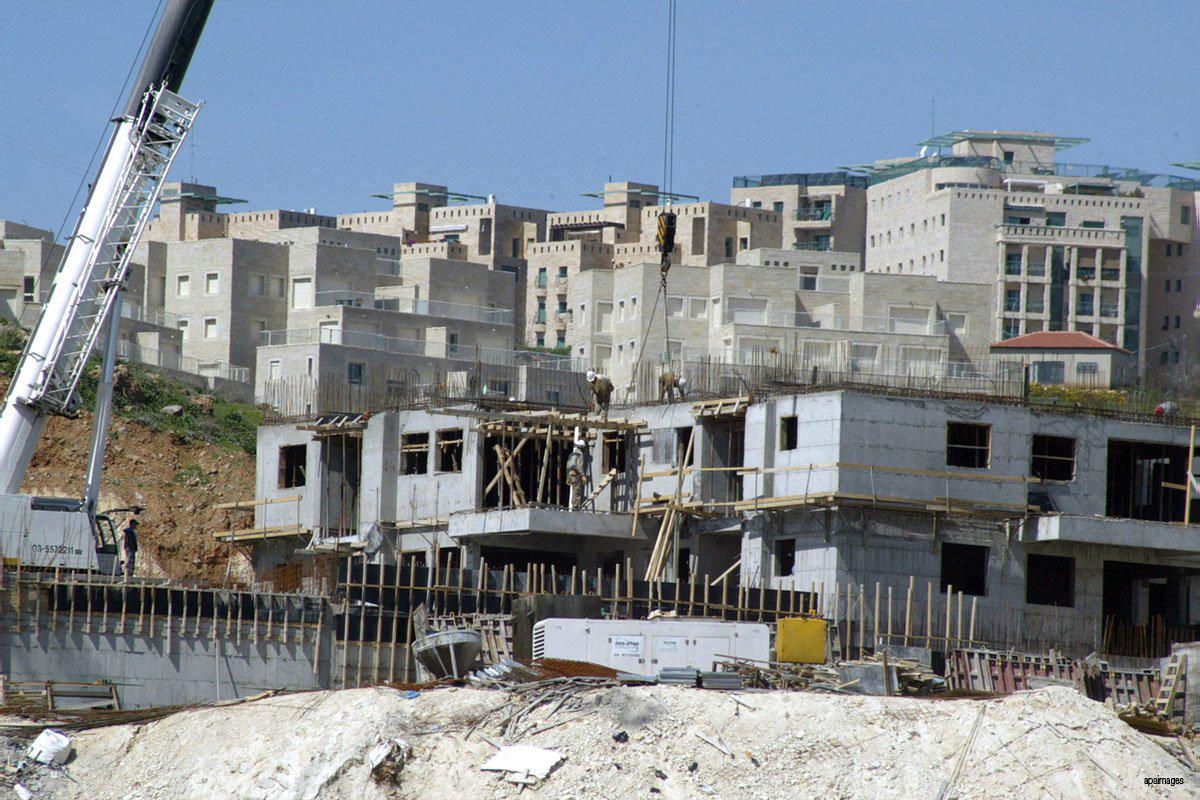
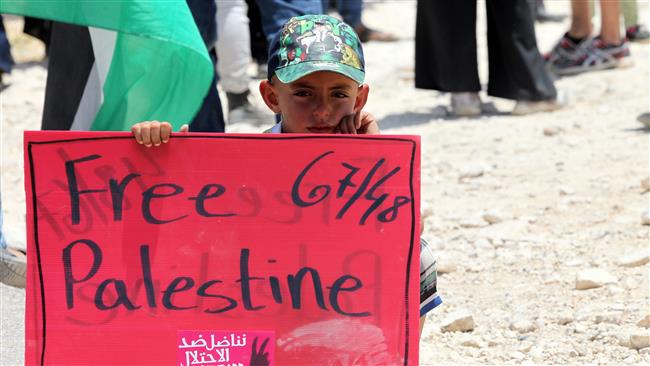

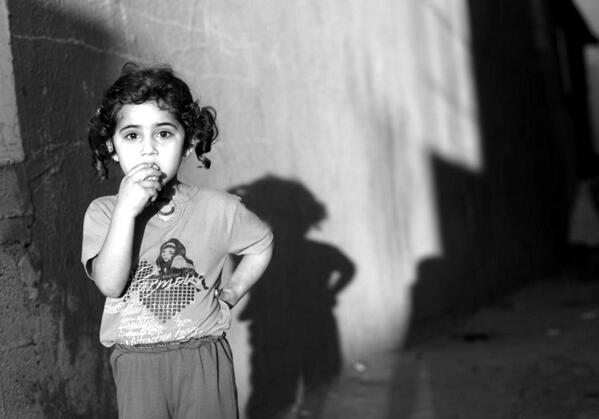




No comments:
Post a Comment